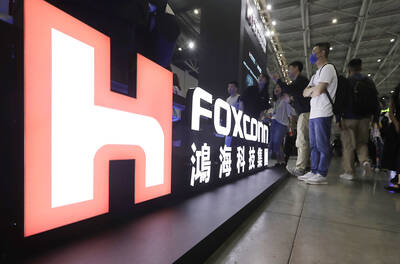When the global recession began to take a toll on high-tech manufacturers in Taiwan, the factories gave their workers a vacation that many would have just as soon skipped.
Putting workers on forced unpaid leave, often for one or more days a week, is a tactic being adopted around the world as firms seek to cut costs and keep skilled workers on the payroll, even if there is little work to do, so that they will have resources when orders pick up.
“When an economic downturn begins to take hold, employers knee-jerk into making dramatic changes,” said Darryl Green, president of Asia Pacific for human resources firm Manpower Inc.
“But there are employers who will stop at nothing to try to retain their valuable workforce. These employers — often in the manufacturing sector where skills are hard to come by — consider innovative alternatives such as shorter working weeks and short-term shutdowns,” Green said.
Employment specialists say the phenomenon is not unique to Taiwan, and is used more broadly by manufacturers in cyclical industries, ranging from electronics makers in South Korea, to car makers in Britain and manufacturers in Germany.
In Taiwan, the trend of forcing workers to take leave without pay, euphemistically called “unpaid vacation” in Chinese, began in the memory chip sector, which experienced its worst-ever slump throughout most of this year.
From there this cost savings measure has quietly spread to other key sectors such as LCD manufacturing and other chips.
In one of the clearest and most sobering signs of the times, Taiwan Semiconductor Manufacturing Co (TSMC, 台積電), the world’s biggest contract chipmaker and one of Taiwan’s most profitable tech firms, said this month it would roll out its own forced leave without pay system next year. TSMC’s main rival, United Microelectronics Corp (UMC, 聯電), is taking similar measures.
Taiwan makes 70 percent of the world’s made-to-order chips, which are used in everything from computers to cellphones and MP3 players. TSMC and UMC, which are the biggest players in Taiwan, saw their collective sales plunge 35 percent last month from a year before, with TSMC posting its worst monthly sales in three years.
TSMC laid down the cold reality of its situation to employees in a Dec. 3 letter from CEO Rick Tsai (蔡力行), who said he feared the current economic downturn could last for a “fairly long time.”
“The company must do its utmost to lower costs,” Tsai wrote. “At the same time, we will also do all we can to protect employees’ jobs. Under these circumstances ... manufacturing departments have decided to take a certain amount of unpaid furlough in December ... All other departments will begin to do the same on Jan. 1.”
SAVING MONEY
In a survey by yes123.com.tw last month, 22.6 percent of the 3,197 respondents said their companies were using forced unpaid leave to save money.
Among those polled, nearly 15 percent said they were being forced to take one, two or even three days off each week.
One such forced leave day each week typically equates to a loss of anywhere from 15 percent to 20 percent of a person’s salary. With an average per capita income of about US$17,500 and a savings rate of 28.68 percent, the loss of such income is making many Taiwanese workers choose between maintaining high savings or cutting their spending, with many opting for the latter.
Economists expect Taiwan’s GDP to be around 1 percent next year, compared with an expected GDP this year of 5 percent.
The use of such cost-cutting measures as forced leave is designed to save millions of dollars for companies, some of which have been bleeding red ink for much of this year.
Taiwan memory chip makers such as Powerchip Semiconductor Corp (力晶半導體), Nanya Technology Co (南亞科技) and ProMOS Technologies Inc (茂德科技) are said to be among the most aggressive users of the practice after posting massive losses in their sector’s worst-ever downturn this year.
Many LCD makers, such as industry leaders AU Optronics (友達光電) and Chi Mei Optoelectronics (奇美), are believed to be taking similar measures as demand slows for flat-screen TVs.
Korean companies that have adopted similar practices include electronics giants Samsung and Hynix, as well as car makers such as SsangYong, the human resources company Mercer said.
Across the Pacific in the US, a similar trend appears to be happening.
The latest US unemployment data showed the number of people working part-time for economic reasons, which economists call involuntary part-time employment, rose to 7.3 million last month, nearly triple the 2.8 million figure from the same month a year earlier.
“There are several reasons for doing it this way,” said a human resources official in the Taipei office of a major international electronics firm, speaking on condition that his and his firm’s names not be used because of the issue’s sensitivity.
“For one, no one knows what the future will bring, so it’s risky to cut people off completely. If companies need to downsize, they can also try this to see if people will leave on their own so they can avoid severance costs,” he said.
HUMAN TOLL
Within the companies themselves, the mood often remains uneasy as many wait to see how long the cuts will last, look for ways to compensate for lost income and fret over the worst-case scenario: layoffs if the situation fails to improve.
“There’s no indication of how long it will go,” one worker said at a major Taiwan electronics firm, who spoke on condition that his and his company’s name would not be used.
“All they’ve said is that once business stabilizes and returns to a more normal level, they’ll take another look and see if this is still necessary. But they didn’t define what ‘stabilize’ and ‘normal’ mean,” he said.
Meanwhile, many workers are bucking up for what looks to be a grim Lunar New Year, which falls late next month, and are keeping their fingers crossed that their jobs will still be around when they go back to work in the Year of the Ox.
Newspaper reports about forced leave, salary freezes and other cost cutting moves at Taiwan tech firms have become commonplace, though mass layoffs are still rare.
“As the financial crisis deepens, companies will inevitably use layoffs as the last resort,” said Jacqueline Ho (何鳳儀), business leader of information production solutions at Mercer Taiwan (美世顧問).
“The timing of the layoffs will depend on a company’s risk and loss tolerance,” Ho said.
FOREIGN WORKERS
Hit by recession and a rising unemployment rate, Taiwan may cut the number of foreign workers in an effort to provide jobs to locals, a newspaper said yesterday.
The Liberty Times quoted Tsai Hsun-hsiung (蔡勳雄), minister without portfolio, as saying that Taipei is studying the possibility of tightening the quota for foreign workers, a move that could create 70,000 to 80,000 jobs for Taiwanese.
“Except for maids and the jobs that Taiwanese do not want to take, we will tighten the quotas for jobs that can be taken by Taiwanese,” the paper quoted him as saying.
For example, currently 20 percent 25 percent of the workers at a construction firm can be foreigners. In future, this quota could be cut to 15 percent, he said.
However, if Taiwan tightens the quota for foreign workers, it would have to subsidize companies because local workers are paid more than foreign workers, he said.
Taiwan has hired more than 300,000 foreign workers, with most of them coming from the Philippines and Thailand.

A proposed 100 percent tariff on chip imports announced by US President Donald Trump could shift more of Taiwan’s semiconductor production overseas, a Taiwan Institute of Economic Research (TIER) researcher said yesterday. Trump’s tariff policy will accelerate the global semiconductor industry’s pace to establish roots in the US, leading to higher supply chain costs and ultimately raising prices of consumer electronics and creating uncertainty for future market demand, Arisa Liu (劉佩真) at the institute’s Taiwan Industry Economics Database said in a telephone interview. Trump’s move signals his intention to "restore the glory of the US semiconductor industry," Liu noted, saying that

On Ireland’s blustery western seaboard, researchers are gleefully flying giant kites — not for fun, but in the hope of generating renewable electricity and sparking a “revolution” in wind energy. “We use a kite to capture the wind and a generator at the bottom of it that captures the power,” said Padraic Doherty of Kitepower, the Dutch firm behind the venture. At its test site in operation since September 2023 near the small town of Bangor Erris, the team transports the vast 60-square-meter kite from a hangar across the lunar-like bogland to a generator. The kite is then attached by a

Foxconn Technology Co (鴻準精密), a metal casing supplier owned by Hon Hai Precision Industry Co (鴻海精密), yesterday announced plans to invest US$1 billion in the US over the next decade as part of its business transformation strategy. The Apple Inc supplier said in a statement that its board approved the investment on Thursday, as part of a transformation strategy focused on precision mold development, smart manufacturing, robotics and advanced automation. The strategy would have a strong emphasis on artificial intelligence (AI), the company added. The company said it aims to build a flexible, intelligent production ecosystem to boost competitiveness and sustainability. Foxconn

STILL UNCLEAR: Several aspects of the policy still need to be clarified, such as whether the exemptions would expand to related products, PwC Taiwan warned The TAIEX surged yesterday, led by gains in Taiwan Semiconductor Manufacturing Co (TSMC, 台積電), after US President Donald Trump announced a sweeping 100 percent tariff on imported semiconductors — while exempting companies operating or building plants in the US, which includes TSMC. The benchmark index jumped 556.41 points, or 2.37 percent, to close at 24,003.77, breaching the 24,000-point level and hitting its highest close this year, Taiwan Stock Exchange (TWSE) data showed. TSMC rose NT$55, or 4.89 percent, to close at a record NT$1,180, as the company is already investing heavily in a multibillion-dollar plant in Arizona that led investors to assume